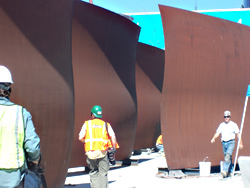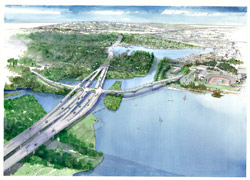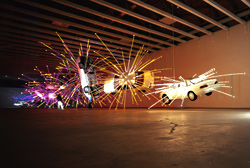On a recent visit to San Diego’s lovely old Balboa Park, I watched as a small child approached one of Niki de Saint Phalle’s vividly kaleidoscopic and cartoonishly voluptuous Nanas. She gazed up at the sculpture that’s bejeweled in brilliantly colorful and reflective mosaics and let out a scream of joy.
I couldn’t have said it better myself.
Forget stuffy art criticism and dusty art history, overly cerebral wall text, ad nauseam analysis of technique. Art appreciation is often mistaken as the domain of snobs. But any child can show you that’s not necessarily so.
For this reason alone, SAM’s Olympic Sculpture Park is one development people of Seattle can be excited about. Whenever it opens (the planned October unveiling has been delayed by the recently settled concrete workers’ strike), Seattle will add an intangible value to its character. A value beyond that of the real estate that the nine acres of park and art will occupy.
Otterlo, the Netherlands. Oslo, Norway. Seattle, Washington. Now, there’s a list that doesn’t readily spring to mind. Yet each of these disparate towns has dedicated space to a large sculpture garden: the splendid 25-hectare Kröller-Müller, the 80-acre Vigeland Sculpture Garden with its population of sexy nudes, and now SAM’s effort. The trend is apparently more European than American.
“I don’t think there’s anything quite like it in the United States, and I think the people have made a very responsible decision and they should be given credit for it,” says sculptor Richard Serra, 67. His massive weathered-steel Wake was the first piece to be placed in the park, in August, where it ripples across a courtyard specially designed for it along Western Avenue. “It does say something about the city that they’ll give over that much property for the enjoyment of sculpture—that’s very far-reaching. And it may actually inspire other cities to do likewise. I think [Seattle’s] ahead of the curve.”
Indeed, it is rather remarkable that Seattle is leapfrogging ahead of major art-rich cities like New York, San Francisco, and Chicago, none of which has devoted such a large chunk of prime downtown real estate to free outdoor public art.
“For a sculptor that’s interested in the evolution of sculpture, the potential of sculpture, it’s a complete gift,” adds Serra, who credits people like local art collectors and philanthropists Virginia and Bagley Wright for having the vision 40 years ago to champion art in general, contemporary sculpture, and Serra himself in particular. (Serra’s first public piece, Wright’s Triangle, commissioned by the namesakes in 1979, sits in Western Washington University’s own sculpture park up in Bellingham.)
Seattle is unlike other, semiblighted cities that have taken on massive art-related projects to rehabilitate their reputations. Cleveland built a rock and roll museum (designed by I. M. Pei) and a science museum on its industrial ruins to redefine its waterfront. Bilbao, Spain, built Frank Gehry’s Guggenheim Museum and a Santiago Calatrava pedestrian bridge, among other delights, to recast its identity as a utilitarian shipping port into a renaissance city of art enlightenment. Aside from possible landfill issues, the OSP site is valuable waterfront land in an already beautiful and desirable city.
The clusters of condominiums springing up around the upcoming park are proof of its appeal, with chichi names like “The Parc,” whose Web site shows a couple posed seductively against a tree with tall buildings in view and flagrantly renames the apparently former Belltown as the “Park District.” A lot of people are literally banking on the success of the park.
At its most fundamental level, a sculpture park liberates art from the hushed, controlled environment of a museum and brings it into the light of day—open to the elements and to the public, often for free. It can be touched, climbed on. In this way, a sculpture park is very democratic, says Serra. It’s a populist thing for a city to do.
Surely this is liberating for an artist, too . . . isn’t it? Well actually, for artists, outdoor art projects prompt their own problems. “For a sculpture to be successful outdoors, it has to convey a sense of place and meaning,” says Louise Bourgeois, whose contribution to the park will be a poetic fountain containing two figures reaching for an unattainable embrace. “The public sculpture cannot function like a decorative piece of jewelry outside. It cannot be an embellishment or a logo,” says Bourgeois. “You always have the problems of scale because the settings are usually problematic or hostile. Then you have to deal with the materials problem, of something holding up outside, which could limit shape and form. Finally, you have the collaborative aspects of these outdoor sculpture projects, which involve many people coming from many different perspectives.”
All these problems aside, when asked what she hopes the public reaction will be to her fountain, Father and Son, once it is installed, the nonagenarian artist replies that she wants her sculpture to enable people “to get in touch with something deep inside themselves. The sculpture is going to affect them, the way they act and feel towards others, particularly those that they love.”
Which, of course, is one of art’s most fundamental functions: provoking a personal response. Until it opens, we can only imagine what the experience of the park will be like, if it will fulfill all the functions it promises: art meditation spot, playground, populist gesture of civic design, creation of an upscale new housing district.
Imagine doing any of these things inside an art museum: singing (between the echoing slabs of a Serra sculpture), having a picnic (between the giant letters of Roy McMakin’s Love and Loss), playing hide and seek, having a birthday party (perhaps attaching balloons to a nearby sculpture), crossing Teresita Fernandez’s Seattle Cloud Cover glass and light bridge in the rain. How about some tai chi? The pure value of the park may be as simple as this: rows of condos held at bay while a child’s vivid kite silently flirts in the wind with the rotating blades of Mark di Suvero’s 22-foot windmill-esque Schubert Sonata.








